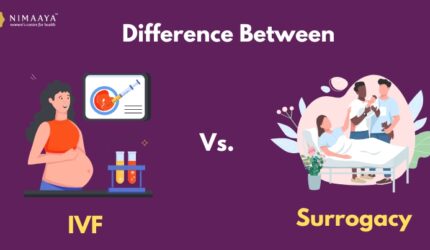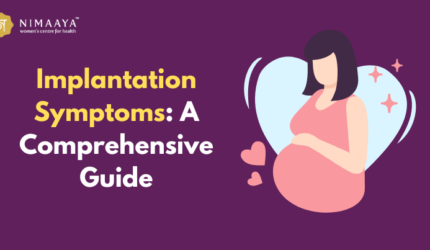The advantages and effectiveness of fresh vs. frozen embryo transfer have been hotly contested topics of discussion. Frozen embryo transfers, as opposed to using fresh embryos during assisted reproductive technology, offer a greater pregnancy success rate, according to numerous fertility professionals and treatment providers. This is because frozen embryos allow for better synchronization between the embryo and the uterus, resulting in a higher likelihood of implantation. Additionally, frozen embryo transfers also provide more flexibility in timing for both the patient and medical professionals involved in the process.
However, success rates aren’t the only determining factor. Choosing fresh over frozen embryos for your transfer could be a better option for you, depending on your circumstances. Factors such as age, medical history, and personal preferences should also be taken into consideration when deciding between fresh and frozen embryo transfers. It is important to consult with your fertility specialist to determine the best option for your circumstances. Let’s explore the factors to take into account while deciding between frozen and fresh embryo transfers for your IVF treatment.
Fresh vs. Frozen Embryo Transfers: Understanding the Differences
❧ Fresh Embryo Transfers:
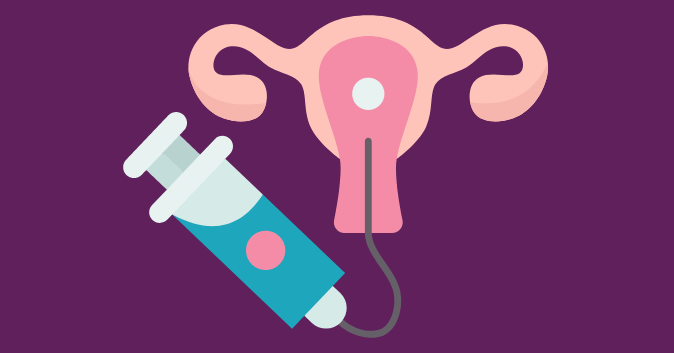
A fresh embryo transfer is typically scheduled 5 days after the eggs are collected from the patient. In the laboratory, the eggs are fertilized with sperm and the resulting embryo is carefully monitored as it grows. The odds of conception are increased by fresh embryo transfer since it provides for a quicker period between egg retrieval and uterine transfer.
However, there are certain situations where a fresh embryo transfer is not recommended. High progesterone levels in patients can interfere with embryo implantation and render a fresh embryo transfer inappropriate. In the same way, a new transfer can be dangerous for a patient susceptible to hyperstimulation from the drugs used to promote egg maturation.
❧ Frozen Embryo Transfers:
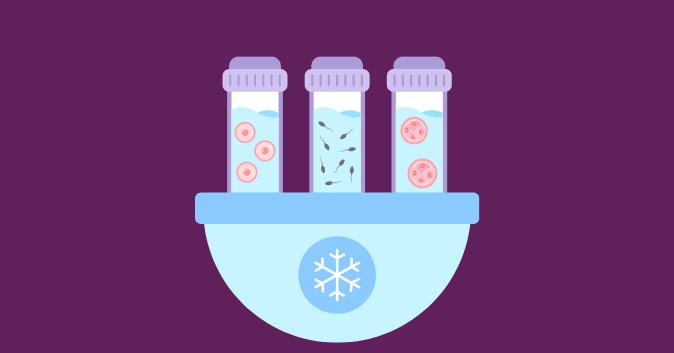
A frozen embryo transfer typically takes place around 6-8 weeks after the embryo has been frozen. When the patient is ready for the transfer, she will be given medications to simulate a natural menstrual cycle. To increase the likelihood of successful implantation, the FET date is then synchronized with the cycle.
A FET is required if a patient wishes to have her embryos examined for genetic issues. Preimplantation genetic testing, or PGT, is carried out soon after the eggs are removed. An embryo is biopsyed, and a small sample is extracted. The sample is examined for chromosomal or genetic abnormalities.
Once PGT is completed, the embryologist will select only the embryos that are chromosomally normal for transfer. The chance of a successful pregnancy is greatly increased by this chosen strategy.
Because embryos can be maintained forever, frozen embryo transfers can also be used for subsequent pregnancies, even years after the original conception. Similarly, if a patient wishes to preserve her fertility due to age, cancer treatment, or other reasons, embryos can be created and stored for later use. A FET can be carried out when the moment is appropriate.
Also Read: Understanding In-Depth the FET Procedure
The Benefits and Drawbacks of Fresh vs. Frozen Embryo Transfer
❥ Advantages of Fresh Embryo Transfer
- Since fresh embryos are transferred shortly after fertilization, there is less waiting time.
- The embryo is not subjected to the stress of freezing and thawing.
- In women who are not hyper-responders, the process of ovarian stimulation during new cycles can lead to a responsive endometrial lining. This, in turn, may enhance the chances of a successful embryo transfer.
❥ Disadvantages of Fresh Embryo Transfer
- Ovarian hyperstimulation syndrome (OHSS), a potentially dangerous ailment characterized by swollen and painful ovaries, can be brought on by ovarian stimulation during new cycles.
- Due to increased fertility medicines and extra hormones, the presence of higher-than-normal hormone levels in a patient’s system can pose challenges for implantation when using their eggs.
- Timing flexibility is limited for fresh transfers because they must be synchronized with the normal menstrual cycle and are time-critical.
❥ Advantages of Frozen Embryo Transfer
- FET provides couples who have encountered challenging situations like cancer treatments with the opportunity to have children once their treatments are completed.
- When a woman is ready, she can schedule a pregnancy. It provides flexibility concerning planning the timing of embryo transfer
- Reduced risk of Ovarian hyperstimulation syndrome.
❥ Disadvantages of Frozen Embryo Transfer
- Not every embryo can withstand the freezing and thawing process, which could lead to a reduced number of embryos available for transfer.
- It can take a long time to undergo frozen embryo transfer.
Success rates for Fresh vs. Frozen Embryo Transfer
➛ Success Rates for Fresh Embryo Transfers
The age of the patient has an impact on the Live Birth Rates (LBR) following fresh embryo transplants. According to studies, LBR was 36.7% for women under 35 years of age, 26.6% for women 35-37 years of age, 15.6% for women 38-40 years of age, and 9.3% for women 41 and older. It is important to consider age as a factor when discussing the success rates of fresh embryo transplants. As women age, the likelihood of achieving a live birth following the procedure decreases significantly.
Age is a key factor in determining the success of fresh embryo transplants, with younger women having higher Live Birth Rates compared to older women. This information underscores the importance of taking age into account when discussing the outcomes of this fertility treatment.
➛ Success Rates for Frozen Embryo Transfers
The LBRs for frozen eggs were 46.7% for women under 35, 38.6% for women 35–37, 29.4% for women 38–40, and 25.9% for women 41 and above, according to studies. When compared to fresh embryo transfers, the success rates for frozen embryo transfers are noticeably greater for all groups.
This data suggests that freezing eggs at a younger age may result in higher success rates when it comes to future fertility treatments. Additionally, frozen embryo transfers offer a promising option for women of all ages looking to preserve their fertility.
Also Read: Preparing for FET: Lifestyle Changes and Pre-Treatment Considerations
What is an Embryo Transfer Cost?
There is no separate embryo transfer cost as it is a part of the IVF treatment procedure. From the stimulation of the ovaries to the extraction of the eggs, fertilization of the eggs in the laboratory with sperm, and the last phase of embryo transfers, the entire process is billed as a single unit. As of 2022, the total cost is approximately Rs 75,000 every cycle. If an embryo is cryopreserved and frozen for subsequent transfer at the woman’s or couple’s request, there is an extra charge of Rs 30,000.
It is important to note that additional costs may arise if any complications or extra procedures are required during the IVF process. Patients should consult with their healthcare provider to fully understand all potential expenses involved. It is also worth mentioning that medication costs, genetic testing, and other optional services may not be included in the base price of IVF.
Patients should inquire about these additional expenses beforehand to avoid any surprises. Overall, it is crucial for individuals considering IVF to thoroughly research and plan for the financial aspects of the treatment.
What Factors need to be taken into account when deciding between Frozen and Fresh Embryo Transfers?
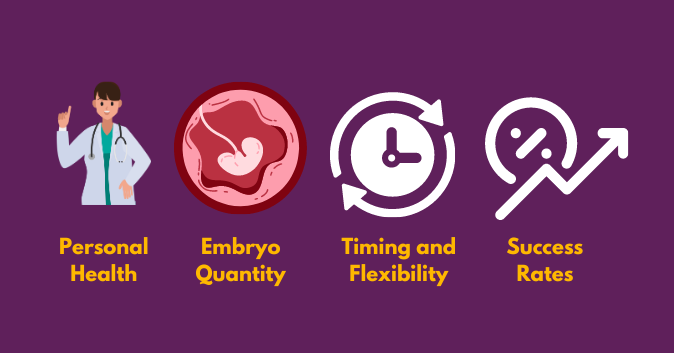
1. Personal Health:
Frozen embryo transfer can be a safer choice if you have other health issues or are at risk of OHSS.
2. Embryo Quantity:
The quantity of embryos at your disposal may affect your decision. If a couple has an excess of good embryos, they could choose to transfer the embryos themselves.
3. Timing and Flexibility:
Consider your schedule, work commitments, and emotional readiness for pregnancy.
4. Success Rates:
Fresh vs. frozen embryo transfer success rates approaches are similar, but factors such as age, embryo quality, and medical history play significant roles.
The decision between Fresh vs. Frozen Embryo Transfers should be made carefully. Depending on your particular situation, one choice might be better than the other. Consult your fertility specialist to find the most appropriate course of action for you.
The age of your embryos, the number of embryos available for transfer, and any health issues that can affect your choice should all be taken into account while assessing your alternatives. Your physician can assist you in evaluating the advantages of each strategy and selecting the transfer type that will work best for you.
Conclusion
The world of infertility can be confusing, but with the right information and assistance from a qualified healthcare provider, you can make decisions that work best for you. Whether you choose to transfer your embryos fresh or frozen, keep in mind that every parent’s journey is different, and while statistics can be useful, it’s important to talk about your options and particular situations with your fertility specialist. At Nimaaya IVF Center, we are committed to providing comprehensive, individualized care to assist you on your path to parenthood. Our team of experts will work closely with you to create a personalized treatment plan that aligns with your goals and values. Make an appointment for a consultation with us right now to begin the process of starting your family.





